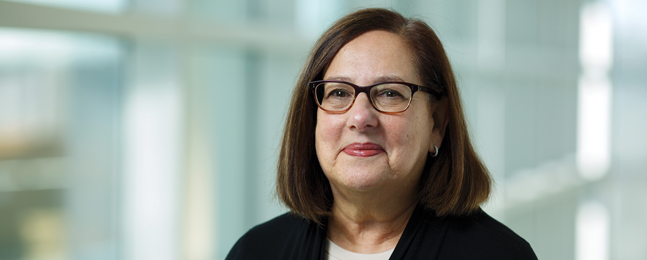Prime Time: The Real Lives of Middle-Aged Americans
Margie Lachman’s psychology research puts doom-and-gloom stereotypes about aging to rest.

Sarah Egan
by Lawrence Goodman
In 1965, The International Journal of Psychoanalysis published an article titled “Death and the Mid-Life Crisis.” In it, Canadian psychologist Elliott Jaques reported he’d discovered a pattern in the lives of some 310 famous artists, who had all entered a stage of heightened genius in their late 30s. As figures like Michelangelo, Bach and Einstein became aware of their own mortality, Jaques wrote, they triumphed over “the misery and despair of suffering and chaos” to create great works of art.
Jaques also reported on a patient he’d treated, Mr. N., whose entry into midlife was marked by a period of “black gloom” brought on by a “knowledge of eventual death.” Mr. N. had a dream about a broken milk bottle that Jaques said symbolized his patient’s longing for the maternal breast, which he unconsciously now recognized was forever out of reach.
Although Jaques’ paper didn’t get much traction in academic circles, 11 years later journalist Gail Sheehy dubbed it a “classic in the field.” In her 1976 book “Passages,” a look at the challenges of adulthood, which she based on interviews with 115 people and which went on to sell 10 million copies, Sheehy said middle age was when “we all confront the reality of our own death. And somehow we must learn to live with it.”
In 1999, Margie Lachman, the Minnie and Harold Fierman Professor of Psychology, appeared on the Today show to tell Americans the midlife crisis was a myth and all the “misery,” “suffering” and “gloom” descriptions were, in the main, inaccurate.
Lachman, who marked her 40th year at Brandeis last fall, is considered one of the premier researchers of psychological development during middle age. She and a group of researchers from across the U.S. are studying the results of the most exhaustive national survey of midlife Americans ever conducted. Only 8% of middle-aged men and women reported having a crisis of the kind Jaques and Sheehy described. Most said they felt happy, healthy, satisfied with their careers and marriage, and optimistic about the future.
While midlife has its own unique stresses — the loss of a parent, a newly empty nest, career setbacks — for many people, it can be the best time of life, Lachman says.
‘The last uncharted period’
When Lachman attended graduate school at Penn State University in the 1970s, academics barely studied midlife. The psychology field was still heavily influenced by Sigmund Freud, who believed life’s most fundamental events occurred during childhood. Researchers compared the college years with old age to show how much humans have declined by the time they reach their 60s.
Midlife, which scholars define roughly as our 40s and 50s, “was considered a time of stasis,” Lachman says. “Nobody thought much changed.”
But German psychologist Paul Baltes, Lachman’s mentor at Penn State, believed individuals adapt during all life stages, including midlife. He saw lifelong development as the result of biological, psychological and societal forces interacting with one another in complex multidirectional, multidimensional patterns. Each life stage, he said, is marked by gains and losses (growth and decline) and includes the constant possibility of change (plasticity).
Baltes, who was forthright with criticism, shaped Lachman’s thinking and research. “He would take you to a new level with his feedback,” she says. “It was great to have somebody who cared enough to help you with what you were doing, and make it much better.”
Lachman came to Brandeis in 1980, drawn by a highly innovative intradisciplinary program that combined developmental and social psychology to study the interactive personal forces and the environmental context that shapes individuals as they change throughout their lives. Such an approach, the consequence of Brandeis’ collaborative spirit of scholarship, was unique at the time, she says.
The psychology field was then heavily dominated by men. The Brandeis psychology department included two female faculty members — Leslie Zebrowitz, now professor emerita of social relations, and Teresa Amabile, now at Harvard Business School. “They were good role models,” Lachman says. “They also had kids, and I really wanted to be in a place that supported a good balance of work and family.”
By the late 1980s, there was a growing realization among academic psychologists that midlife needed further study. “Midlife was being referred to as the last uncharted period of the life course,” Lachman says.
To remedy this, she and 12 other researchers from around the globe started what became known as the Midlife Development in the U.S. (MIDUS) project. In 1995, MIDUS began surveying 7,100 Americans between the ages of 25-75 on almost every aspect of their lives. Respondents were asked how often they felt depressed, angry, irritable, happy or optimistic. To describe their relations with children, spouses, religious leaders and neighbors. Whether they had cancer, an eating disorder, heart disease or high blood pressure. Whether they had pain during sex, had experienced childhood trauma, had been through menopause, regularly paid their taxes, had ever served on a jury, had been “born again” or received welfare. In her book “In Our Prime: The Invention of Middle Age,” journalist Patricia Cohen calls “the breadth and depth” of the MIDUS project “unprecedented.”
The MIDUS results shattered the whole concept of a midlife crisis. The vast majority of middle-aged Americans declared their health was excellent, their marriages were strong and their finances were under control. They reported a high level of satisfaction with sex, family life and careers. Menopause turned out to be no big deal either. More than 60% of women said they felt “only relief” when their periods ended, Cohen writes.
During Lachman’s 1999 Today show appearance, she was asked about the popular conception of Americans buying a sports car or cheating on their spouse to remedy a midlife crisis. “We saw very little of that,” she said. Though studies have shown bouts of depression are most prevalent in midlife, Lachman’s research shows that, overall, optimism increases during middle age.
In recent years, scholars have focused on so-called deaths of despair — mostly caused by suicide, opioid overdoses and alcohol-related illnesses — which are most common among the middle-aged. But these mental-health issues are heavily concentrated among white Americans without a four-year college degree, and may be more related to social, cultural and economic factors than age.

Mike Lovett
Margie Lachman
page 2 of 4
Digging into the data
MIDUS, which received additional funding in 2002 and again in 2011, remains ongoing. More than 1,400 scientific papers have been published using the data. Lachman herself has made extensive use of the data, producing an overall conceptual framework for understanding midlife.
During midlife, adults experience fundamental shifts in their societal and familial roles, moving up the career ladder, for example, or becoming empty nesters. Some experience financial hardship or find themselves caring for an ailing parent. Although such changes produce considerable stress, midlife adults can manage them, because with age comes an increase in emotional control, practical intelligence and wisdom. Greater experience brings gains in skills and mastery. In fact, adults reach the apex of their competence and expertise in middle age.
There is evidence that innate personality and genes play a significant role in determining midlife development, says Lachman. Childhood temperament has been found to persist into adulthood, having an impact on adult personality as well as midlife success in personal relationships, parenting, education and career.
Yet you can still change a lot about yourself during middle age. The advantages midlife adults possess in knowledge, self-control and navigating relationships enable them to overcome adverse childhood events such as parental divorce or death. Even the effects of childhood trauma can be somewhat mitigated, Lachman says.
Midlife adults can also plot a course that enables them to change the future — exercising more to have better health in old age, for instance, or changing psychologically to reduce stress and become happier.
When the second stage of MIDUS began in 2002, researchers expanded their work to study cognition, which includes remembering, reasoning, the ability to switch tasks or learn new information, and other higher-level brain functions. But the tools that existed for assessing people’s cognition in the lab were not sensitive enough to test normal, healthy adults via a telephone call. Lachman helped develop a new questionnaire that was both comprehensive and easy to administer by phone.
“Some of the questions will be easy for you, and some will be harder,” Lachman’s 15-minute Brief Test of Adult Cognition by Telephone (BTACT) began. “We do not expect anyone to get all these correct; just do the best you can.”
For instance, study participants were read a list of 15 words, asked to recall as many as they could immediately and then again 20 minutes later. They were given a series of numbers arranged in a specific pattern — for example, 35, 30, 25, 20, 15 — and asked what number would come next. They counted backward as quickly as they could for 30 seconds. They were given a category, such as “fruits” or “animals,” and asked to list as many examples as they could in 90 seconds.
Two years ago, Lachman and several colleagues revealed a major finding of the BTACT. Midlife adults showed a “very small although statistically significant” decline on some but not all aspects of cognitive performance.
Among the roughly 2,500 adults she and her team studied over the course of nine years, the steepest drop was in processing speed — how quickly you can take in information and make a decision — which begins declining during the 30s and 40s. Memory for lists of words showed declines as people move from their 50s into their 60s.
By deep-mining the MIDUS data for attributes and characteristics of people taking the BTACT, Lachman has been able to link personality traits and life experiences to cognitive decline. People who suffer severe emotional distress in child- or adulthood show greater cognitive decline than individuals who don’t. Higher levels of education correlate with stronger brain function and lower dementia risk.
Extroverted individuals do better on tests of long-term memory but worse on reasoning tests, perhaps because extroverts spend less time thinking through problems. Those who are depressed or neurotic also score lower in reasoning. Women outperform men in both delayed and immediate word recall. Men outperform women in “executive functioning” skills, like focusing attention, planning, problem-solving and multitasking.
As many other studies demonstrate, Lachman’s research shows that frequent cognitive activities, such as writing, reading and playing word games, are associated with better brain performance. And she goes a step further: Her data show that frequent computer use is also linked to improved cognitive skills.
Overall, the people who do best on the BTACT have three things going for them — strong social support; frequent physical activity; and the conviction that they can, with practice, improve their cognitive functioning. In fact, Lachman has found that older adults who enjoy all three often have the same level of good health that younger and middle-aged adults have.

Sarah Egan
page 3 of 4
Mind over midlife
In her research, Lachman is interested in how middle-aged and older adults respond to statements like these: “I can do just about anything I really set my mind to.” “When I really want to do something, I usually find a way to succeed at it.” “What happens in my life is often beyond my control.” “I sometimes feel I am being pushed around in my life.”
How much people agree or disagree with these sentiments represents their “control beliefs,” their sense that they can direct their own fate. As it happens, Americans have the strongest control beliefs of any nation in the world.
These beliefs weaken as we age. Even so, in the MIDUS study 62% of Americans 60 and older said they disagreed with the statement “What happens in my life is beyond my control.” (As a comparison, 80% of individuals between 25-39 and 71% of the middle-aged also disagreed with the statement.)
Over the years, Lachman and other researchers have linked strong control beliefs to greater life satisfaction, a more optimistic outlook on life, less depression, better memory and intellectual functioning, and a lower mortality rate. “There’s a basic human need to have control of your life,” Lachman says. “When people feel they don’t have control, their psychological and physical health suffers.”
The power of your control beliefs lies in your ability to control your behavior. “If you think there’s something you can do, then you’re going to do it,” Lachman says. And if you succeed, your self-confidence is boosted, and your control beliefs are strengthened. It becomes a feedback loop.
In a 2011 study, Lachman and her then postdoctoral research fellow Stefan Agrigoroaei surveyed 152 adults between the ages of 22-84 on their control beliefs about memory. Participants were asked to rate their agreement with such statements as “I know if I keep using my memory, I will never lose it” and “There’s nothing I can do to preserve my mental clarity.” They were then read a list of 30 words and asked to recall them 25 minutes later. Participants who had expressed stronger control beliefs were able to remember more words.
Lachman has two explanations for this result. Before taking the memory test, the people in the study had been asked about their level of stress. Those who thought they had little control over their cognitive abilities reported being more nervous. So it’s possible, Lachman says, that anxiety interfered with these individuals’ ability to remember.
At the same time, she says, individuals with strong control beliefs were more apt to use a mnemonic to remember the words. They mentally categorized the words into groups. Their confidence in their memory may have given them additional intellectual resources to tackle the memory test.
Lachman has also looked at how control beliefs are related to disparities in income and education. Lower-income and less-educated groups have weaker control beliefs. They believe they are constrained by many factors beyond their control and will have a tougher time achieving their goals.
One reason for this may be their health. Lower-income and less-educated Americans experience higher rates of disease, disability and death than higher-income and better-educated Americans. But Lachman has found that lower-income and less-educated Americans with strong control beliefs are able to bridge this gap. Their health is roughly on par with that of more-advantaged Americans.
Control beliefs “are not about wishful thinking or the power of positive thinking,” says Lachman. “But you can perceive the situation you’re in in different ways, and that can have a huge impact on what happens.”
Keep calm, and start moving
In recent years, Lachman has focused on persuading Americans to increase their physical activity. Nearly 80% of U.S. adults don’t get the recommended levels of physical activity, though the evidence for its health benefits is overwhelming. Being sedentary puts you at greater risk for cancer, heart disease, depression, Type 2 diabetes and Alzheimer’s.
Although there’s no magic bullet for improving Americans’ health, Lachman believes promoting exercise is as close to one as you can get. “Exercise just has huge physical and psychological benefits,” she says.

Sarah Egan
page 4 of 4
Seven years ago, Lachman, in collaboration with Boston College, Northeastern University, Boston University and Hebrew SeniorLife, co-founded the Boston Roybal Center for Active Lifestyle Interventions. So far, the center has developed and funded roughly a dozen pilot projects aimed at getting adults to move more.
In one of the projects, Lachman and several colleagues worked with 63 Boston-area adults to create a plan for increasing how much they walk. Most people want — but fail — to exercise more. Lachman’s study aimed to bridge the gap between intentions and behavior.
Each participant was asked to write down when, where and how they would increase their daily steps. For instance, they could park their car farther away from their office or take the stairs instead of the escalator when shopping at a mall. Participants also received personalized maps of their neighborhoods and workplaces that included the number of steps it would take to reach certain destinations.
The intervention worked. The Fitbits the study subjects wore showed they, on average, increased their walking by 2,000 steps each week over the course of four weeks. Lachman says the experiment indicates adults benefit from personalized exercise plans, in which they set their own targets and make plans to achieve them.
Unfortunately, the increase in physical activity didn’t stick. Once the study ended, the participants went back to their previous levels of physical activity. Lachman says four weeks may be too short a period to change habits. Not only that, people may need ongoing social support, either from others also trying to increase their walking, or from friends, family or personal trainers.
So, working with postdoc researcher Mirjam Stieger, Lachman is currently looking at another approach to improving fitness — changing people’s personalities. Before Stieger came to Brandeis, she developed a method for increasing an individual’s conscientiousness, the ability to stay organized, work hard and pursue objectives. She asked study participants to set a goal — such as going to the gym more often or spending less time on the computer. Participants then received regular text messages reminding them of their goal and their reasons for wanting to achieve it.
“Good morning,” one text said. “Here is a reflective task for you: Imagine what advantages it would have for your short-term and long-term goals if you were to carry out your desired behaviors.”
Another text asked participants to identify the obstacles that hindered them from showing their desired behaviors and to think about how those obstacles could be overcome.
After two weeks, the people in the study reported more self-discipline and focus. And their level of conscientiousness, as measured by a well-established personality survey, had increased.
Now Stieger and Lachman are developing a smartphone app that can boost conscientiousness in people who want to exercise more. “We really think this has a good shot of working,” Stieger says.
If it does, it will be a huge step toward the goal Lachman has been striving toward her whole career — helping millions of Americans lead a healthy, happy midlife and old age.
